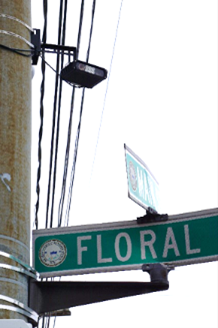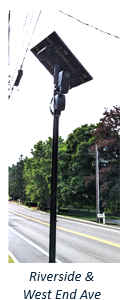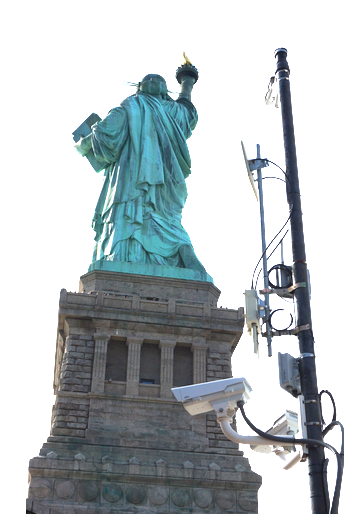Get ready: Governor Hochul is now building a mass surveillance system across the upstate region. And it’s coming this month to your local police department and county Sheriff. The end product? Cameras that can record and track every car entering and moving about Broome County, with results transmitted to the regional intelligence center in downtown Binghamton and onward across the nation. All without your consent.

Automated License Plate Readers (ALPRs) and surveillance cameras have for over ten years been seeded across the county by city police departments, the sheriff, and Binghamton University. License plate cameras were first installed in 2017 at major entrances to Binghamton at a reported cost of $700,000. A network of surveillance cameras has also long been mounted in downtown areas, undisclosed neighborhood locations, and on local buses.
Local residents have also steadily opposed each new effort at mounting more cameras, the collection of new data on them, and the growing invasion of privacy rights. Nationally mass surveillance systems like this have been opposed by conservatives critical of the “deep state,” libertarians, and the liberal ACLU.
Follow the new tech and new $
What is being proposed today is however far more formidable and threatening for two reasons.

One, the technology is now far more advanced, from more capable facial and night recognition cameras, through coordinated data collection and distribution beyond the local area, to the use of new computer algorithms and artificial intelligence (AI) to create and compile personal profiles and data bases. Two, the state has committed massive funding to create a nation-wide system far beyond previous capabilities.
In June 2023 WNBF reported that a wave of more advanced cameras were being installed around Binghamton. Powered by solar cells, the new cameras are made in Vietnam for Flock Security Cameras and do much more than check on single plate numbers. Other local city governments are following along including Endicott, Johnson City, Vestal, and SUNY-Binghamton. For those who look up, the cameras are expanding across entrances to the triple cities, public streets, and increasingly are posted outside our homes. And they can be mobile too, being mounted on the trunks and roofs of cars.

What is coming in the next few weeks is however far far larger: $2.5 million for more surveillance equipment in the coming year alone. The first step? The Broome County legislature will meet on June 20th to vote on $800,000+ for the Sheriff’s proposed cameras.
This is a bipartisan effort. On May 13th Governor Kathy Hochul’s announced a surprise $127 million to fund new surveillance technology for upstate police departments and county sheriffs. Republican Sheriff Frederick Akshar was quick to praise the Democratic Governor’s award announcement. Akshar was awarded $834,118, the City of Binghamton Police Department won $468,668, the Johnson City Police Department was allocated $136,100, Endicott Police Department got $770,000, and the Vestal Police Department retrieved $211,700.
What will this do?
Sheriffs and Police chiefs promote camera surveillance as a tool to check license plates against lists of stolen cars or cars associated with child abduction (AMBER) alerts. If it was this simple, they would search for and identify known cars from statewide hot lists. But what is being designed and built is something quite different, for plate readers and surveillance cameras capture much more: the endless passage of cars and persons which are scanned, decomposed, and correlated across multiple jurisdictions—and without constraints are kept forever in police and state databases across the country.

New technologies with new funding allow every car entering the county and moving along city streets to be scanned, analysed and distributed. Police now can record the comings and goings of everyone, including trips to doctor’s offices, churches, synagogues and mosques, and any political gathering. Portraits of drivers’ lives over time are easily constructed based on past patterns of movement and behavior revealed by data collected over time. Contracts signed with corporate camera and surveillance companies leave open the centralization of data across the country.
And as many have shown, these technologies, especially when linked to privately controlled cameras, targeted poor communities and people of color—and are racially biased by a technology that consistently generates false identifications, a process promoted and used by racial vigilantes. What they don’t do is prevent crime as is so often claimed, as reported by many analysts from Forbes magazine, the “Capitalist Tool” to studies by the University Michigan.
Regular and unnoticed funding has been passed by city councils across the county for several years. At the last Binghamton City Council meeting on June 5th a request for $60,000 for new cameras was presented—and was opposed this time by a stream of unaffiliated persons, including the author, who each took the limited 5 minutes allowed to oppose yet more surveillance funding.
The push is driven by both the surveillance state and profit-maximizing private corporations. Private firms like Flock, the City of Binghamton’s contractor, provide cameras, software, and centralized data collection and reporting. Linking city to city, alongside neighborhood watches and private customers, Flock now coordinates data from thousands of cities in almost all states. Vigilant Solutions, a subsidiary of Motorola, is trying to sell the same.
Centralized Surveillance Downtown

Data compiled by multiple police departments and sheriffs meet in the Southern Tier Crime Analysis Center, one of ten Centers in the state created with local, state and federal funding. Created over ten years ago, the Center was recently expanded with $500,000 in state funds and is now five times the original size, collating data and intelligence from nearly 40 agencies. Its Board includes representatives from state and local police agencies, including the Binghamton University Police Department. It portends nothing less than centralized mass surveillance system of Orwellian scope: a giant data network that records people’s comings and goings, locations, and repetitive destinations.
The abuses are already legendary. Cars misidentified as stolen have led to police brutality of their African American women and youth drivers and passengers. Police officers have used information for extortion, stalking estranged partners, and targeting those parked near religious buildings. Readers can also focus on immigrant and reproductive service providers and their clients; local police have shared data with ICE and agencies outside their city and state.
Consider the conclusions of the 2023 report by the University of Michigan: “Recent studies examining the accuracy of ALPRs show that they often misread license plates, leading to disastrous real-world consequences” including violent arrests of innocent people. And “even when ALPRs work as intended, the vast majority of images taken are not connected to any criminal activity.”
It gets worse: “A 2016 Associated Press report disovered hundreds of cases of officers all over the country who had misused confidential databases ‘to get information on romantic partners, business associates, neighbors, journalists and others for reasons that have nothing to do with daily police work.’ Professional abuse includes targeting religious minorities and communities of color. Reproductive rights advocates are now raising alarms about the ways police and others could use ALPRs for the targeting of abortion clinics in the wake of the Supreme Court’s Dobbs decision that overturned Roe v. Wade.”
What can we do at the city/county level?
ACLU has published online a useful guide on “How to Pump the Brakes on Your Police Department’s Use of Flock’s Mass Surveillance License Plate Readers” (see also their 2022 white paper and 2013 report). It only covers license plate readers, but it is a good start.
Local legislators should, as some do around the country, balk at endorsing mass invasion of our privacy. If they are unable to stop surveillance, they should at the very least impose specific limits on any cameras put in use by
- Regulating what data is collected and how long it is retained
- Limiting who has access to the data, and
- Specifying how data is used by law enforcement
License plate numbers can be run against a watchlist in seconds but they need not be retained or shared thereafter. Some states by law require captured data to be deleted within 3 minutes. Local city and village councils might require this and specify strict limits in law and in any agreements with surveillance and camera contracts. Following New Hampshire law, legislatures can pass a law and implement in all contracts:
“Notwithstanding any provision to the contrary, ALPR photos or data captured by the customer’s cameras, or any data generated therefrom, shall be deleted and destroyed by Flock in no more than three minutes after such photos or data are first captured by, provided to, or shared with providers, unless otherwise required by applicable law.”
Denying data to those residing outside the county is a further step, preventing the use of political authorizes in other states and in many cases nations from tapping your personal images and movements. This too can be prevented through language in city law and contracts that state
“Notwithstanding any provision to the contrary, photos or data captured by city (or county) camera, or data produced therefrom, shall not be sent to, shared with, or used by or for any other person or entity.”
Resources and Further Reading
Farivar, Cyrus. “Flock Installed AI Cameras In This Small City and Claimed Crime Went Down. It Went Up”. Forbes
Automated License Plate Readers: Legal and Policy Evaluation | Science, Technology and Public Policy (STPP)”. stpp.fordschool.umich.edu.
Automated License Plate Readers Threaten Our Privacy (Electronic Frontier Foundation (EFF)/ACLU)
You Are Being Tracked (ACLU)
Guariglia, Jason Kelley and Matthew (2020-09-14). “Things to Know Before Your Neighborhood Installs an Automated License Plate Reader”. EFF
Matsakis, Louise (2021-10-24). “Can License Plate Readers Really Reduce Crime?”. Wired. ISSN 1059-1028.
Street Level Surveillance Hub, (EFF)
- The Atlas of Surveillance, EFF’s collaboration with the Reynolds School of Journalism at the University of Nevada, Reno to map more than 12,000 police surveillance technologies in use across America; and
- Spot the Surveillance, EFF an open-source educational virtual reality tool to help people identify street-level surveillance in their community.
The Four Flavors of Automated License Plate Reader Technology and Things to Know Before Your Neighborhood Installs an Automated License Plate Reader (EFF)
